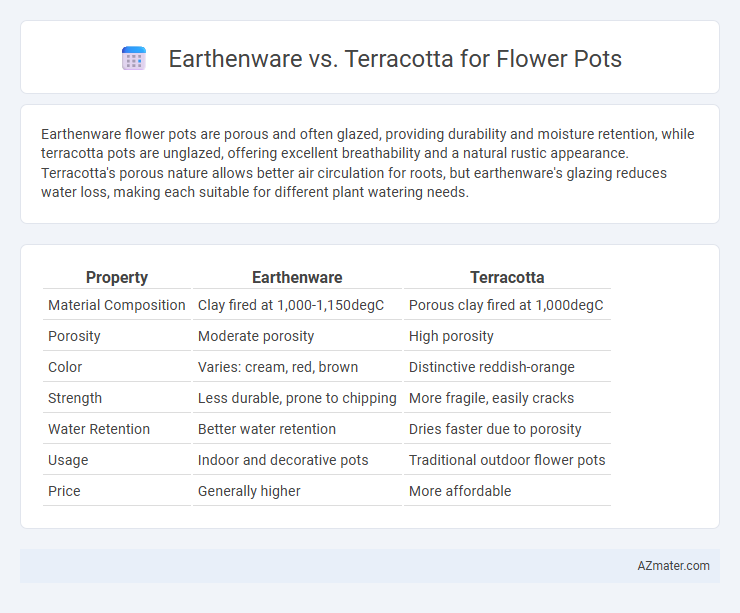Earthenware flower pots are porous and often glazed, providing durability and moisture retention, while terracotta pots are unglazed, offering excellent breathability and a natural rustic appearance. Terracotta's porous nature allows better air circulation for roots, but earthenware's glazing reduces water loss, making each suitable for different plant watering needs.
Table of Comparison
| Property | Earthenware | Terracotta |
|---|---|---|
| Material Composition | Clay fired at 1,000-1,150degC | Porous clay fired at 1,000degC |
| Porosity | Moderate porosity | High porosity |
| Color | Varies: cream, red, brown | Distinctive reddish-orange |
| Strength | Less durable, prone to chipping | More fragile, easily cracks |
| Water Retention | Better water retention | Dries faster due to porosity |
| Usage | Indoor and decorative pots | Traditional outdoor flower pots |
| Price | Generally higher | More affordable |
Introduction to Earthenware and Terracotta Flower Pots
Earthenware flower pots are porous ceramic containers fired at lower temperatures, offering breathability that promotes healthy root growth and moisture regulation. Terracotta pots, a subset of earthenware, are made from natural clay with a distinctive reddish-brown color and a slightly more durable composition due to partial vitrification. Both materials provide excellent insulation for plants but differ in texture and water retention, influencing plant care and aesthetic appeal.
What is Earthenware?
Earthenware is a type of ceramic material made from natural clay fired at relatively low temperatures, resulting in a porous and somewhat fragile structure compared to stoneware or porcelain. It is commonly used for flower pots due to its excellent breathability, which allows air and moisture to pass through the walls, promoting healthy root growth. Earthenware flower pots often have a glazed or unglazed finish, with unglazed pots providing better drainage and moisture regulation for plants.
What is Terracotta?
Terracotta is a type of earthenware made from natural clay, fired at lower temperatures to achieve a porous, reddish-brown finish ideal for flower pots. This material allows for excellent breathability and moisture regulation, aiding healthy root growth and preventing overwatering. Compared to other earthenware, terracotta pots are lighter, more affordable, and develop a natural patina over time, enhancing their rustic charm in garden settings.
Material Composition and Properties
Earthenware flower pots are crafted from clay fired at lower temperatures, resulting in a porous material that retains moisture well but is less durable and more prone to chipping than terracotta. Terracotta, made from specific iron-rich clays and fired at higher temperatures, offers greater strength, breathability, and a characteristic reddish-brown color that enhances root aeration and soil drainage. Both materials support healthy plant growth, but terracotta's denser composition provides improved longevity and resistance to weathering compared to traditional earthenware.
Durability and Longevity Comparison
Earthenware flower pots are porous and prone to chipping, offering moderate durability ideal for indoor use or sheltered areas. Terracotta pots, made from fired clay, provide enhanced strength and breathability but can crack in freezing temperatures if left outdoors. Terracotta's longevity surpasses earthenware when properly cared for, making it a preferred choice for long-term plant cultivation in temperate climates.
Water Absorption and Breathability
Earthenware flower pots have higher water absorption rates, allowing moisture to seep through the porous material, which helps maintain consistent soil hydration. Terracotta pots, a type of earthenware, offer superior breathability due to their clay composition and firing process, promoting air circulation to plant roots and preventing waterlogging. Both materials support plant health by balancing moisture retention and airflow, but terracotta's slightly enhanced porosity makes it ideal for plants requiring well-drained conditions.
Aesthetic Differences and Color Options
Earthenware flower pots offer a smooth texture and come in a broader range of vibrant colors, including glazed finishes that enhance aesthetic appeal. Terracotta pots are recognized for their warm, natural reddish-brown hue and porous surface, which develops a rustic charm over time. While earthenware allows for decorative versatility, terracotta provides an earthy, traditional look favored in Mediterranean and cottage-style gardens.
Suitability for Different Plant Types
Earthenware flower pots offer excellent moisture retention, making them ideal for moisture-loving plants such as ferns and begonias, while terracotta pots provide superior breathability, which suits drought-tolerant plants like succulents and cacti. Terracotta's porous nature allows for better air circulation and prevents soil from becoming waterlogged, benefiting plants that require well-drained conditions. Earthenware pots, often glazed, retain water longer and are preferable for plants needing consistent moisture levels.
Cost and Availability
Earthenware flower pots are generally more affordable and widely available in garden centers and online retailers due to mass production and common clay materials. Terracotta pots, made from a specific type of porous clay, often come at a slightly higher price point but offer better breathability for plant roots. Both options are accessible, but earthenware provides a budget-friendly choice while terracotta delivers enhanced durability and moisture regulation.
Choosing the Right Pot: Earthenware or Terracotta?
Choosing the right flower pot between earthenware and terracotta depends on durability and moisture retention needs; earthenware offers a glazed finish that retains water longer, making it ideal for moisture-loving plants, while terracotta's porous nature allows better air circulation and drainage, benefiting drought-tolerant species. Terracotta pots are generally lighter and more breathable but prone to cracking in freezing temperatures, whereas earthenware provides a sturdier, frost-resistant option with a variety of decorative glazes. Understanding these material differences aids gardeners in selecting the optimal pot for plant health and aesthetic preferences.

Infographic: Earthenware vs Terracotta for Flower Pot
 azmater.com
azmater.com